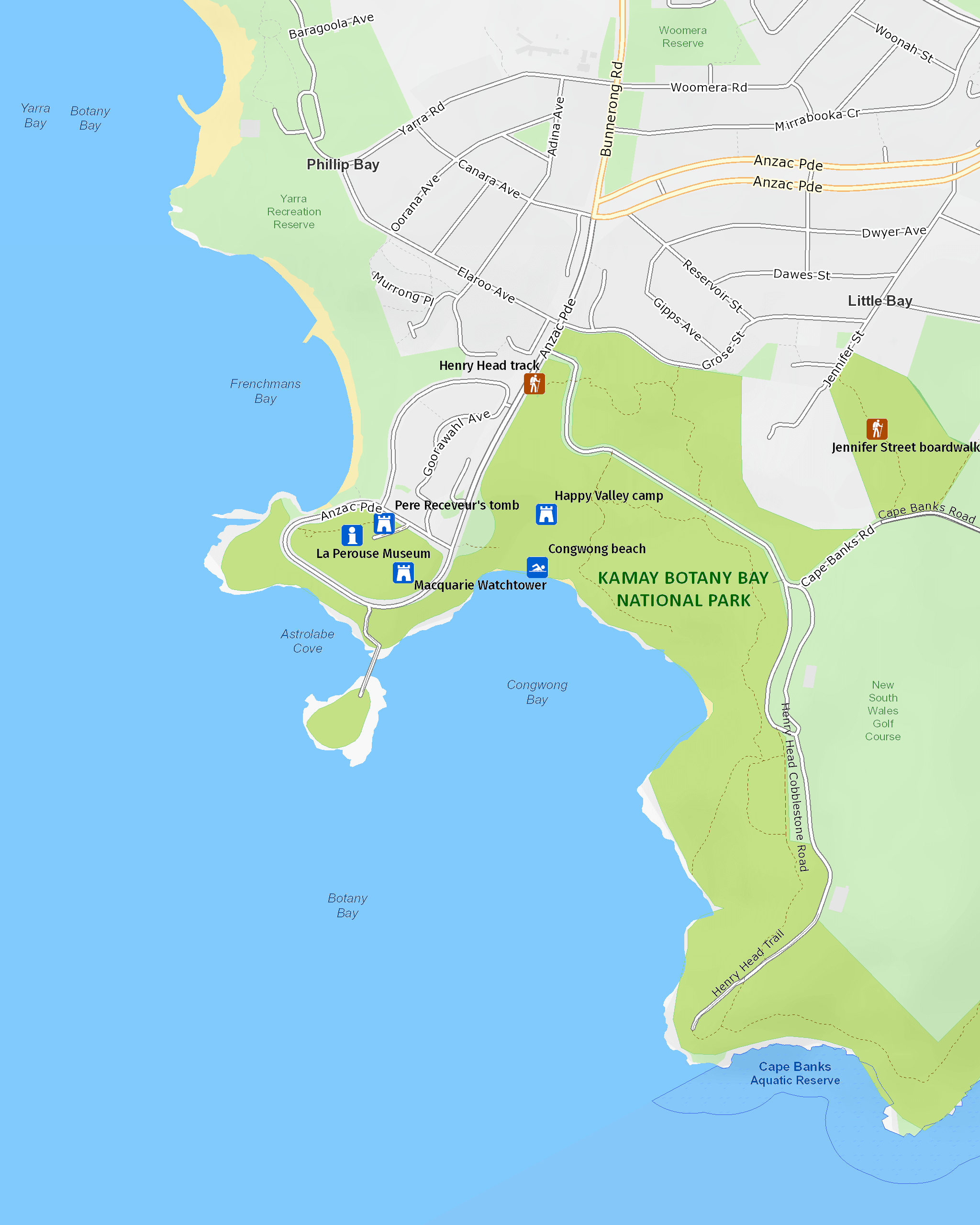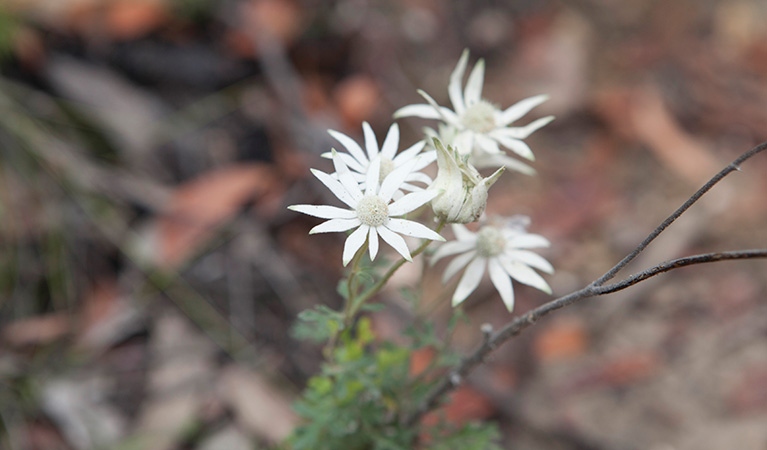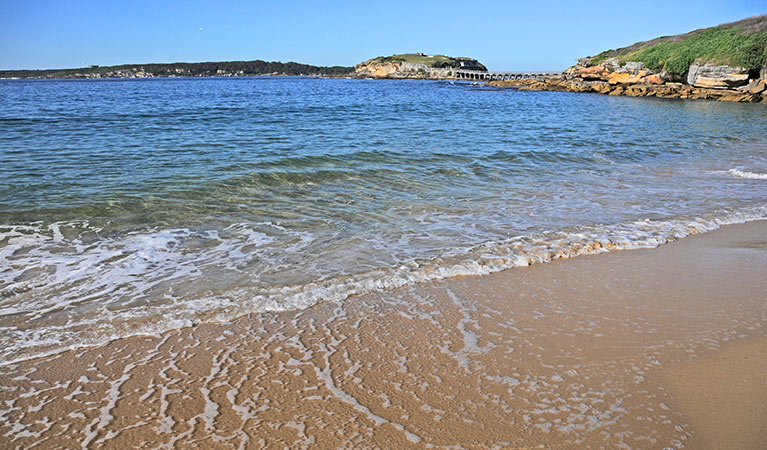Overview
Visit beautiful Congwong Beach, in La Perouse, perfect for swimming, picnics, snorkelling and fishing. Only 15km from central Sydney, this family friendly beach is also close to cafes and walks.
- Accessibility
- No wheelchair access
- What to
bring - Hat, sunscreen, suitable clothing
- Please note
- Congwong Beach is accessed via a 100m path at the southern end of Cann Park. The path has a number of steps.
- You can also take Congwong trail, which starts along Henry Head Lane, near the park entry gates.
- It’s a good idea to avoid swimming at Congwong Beach during and for 24 hours after heavy rain.
Congwong Beach is a perfect spot for a relaxing family day out in Sydney’s Kamay Botany National Park. Easy to reach from Cann Park in La Perouse, via a 100m path with steps, this sheltered sandy beach is great for children.
Lounge on your beach blanket, surrounded by nature, and take in beautiful views of Botany Bay and Bare Island. Bathe in gently lapping waves, or head to the rocky outcrops at either end of the beach to cast your fishing line. Congwong Beach and nearby Bare Island are popular spots for snorkelling and scuba diving, especially in spring and autumn.
It’s an ideal spot to cool off after hiking the return walking tracks to Henry Head and Cape Banks, or cycling the La Perouse loop.
Watch seabirds dip and dive and keep an eye out for passing dolphins as you enjoy a beach picnic. Or, head to local cafes for lunch or dinner. Don’t forget to take in the local history at Bare Island Fort and La Perouse Museum.
Also see
-

Happy Valley camp
Visit the site of Happy Valley camp, an historic Depression-era community located behind Congwong Beach, in La Perouse. It’s one of many fascinating historic sites in Kamay Botany Bay National Park.
Map

Map legend

Local alerts
For the latest updates on fires, closures and other alerts in this area, see https://www.nationalparks.nsw.gov.au/things-to-do/swimming-spots/congwong-beach/local-alerts
General enquiries
- National Parks Contact Centre
- 7am to 7pm daily
- 1300 072 757 (13000 PARKS) for the cost of a local call within Australia excluding mobiles
- parks.info@environment.nsw.gov.au
Park info
- in the La Perouse area of Kamay Botany Bay National Park in the Sydney and surrounds region
7am–8.30pm November to March.
7am–7.30pm April to October.
La Perouse park entry gate closed to vehicles between 7pm and 5am all year.
Areas may have to close at times due to poor weather or fire danger.
-
There are no park entry fees in La Perouse area but you'll need to pay to tour Bare Island. Park entry fees apply in the Kurnell area of Kamay Botany Bay National Park, only.
Buy annual pass.
Visitor info
All the practical information you need to know about Congwong Beach.
Getting there and parking
Congwong Beach is in the La Perouse area of Kamay Botany Bay National Park, around 17km from Circular Quay. To get to get there from Sydney follow Anzac Parade south to La Perouse.
To access Congwong Beach:
- From the sign at the south end of Cann Park, take the 100m path down to the beach.
- From the carpark on Anzac Parade, opposite Endeavour Avenue, follow the Congwong trail
Road quality
- Sealed roads
Vehicle access
- 2WD vehicles
Weather restrictions
- All weather
Parking
- Parking is available at Cann Park, near La Perouse Museum.
- You can also park near the park entry gates, on Anzac Parade, opposite Goorawahl Avenue.
By public transport
Take bus L94 or 394 to La Perouse from Circular Quay, Martin Place, or Hyde Park via Maroubra Junction. Visit Transport for NSW for details.
Facilities
- Public toilets are located on Anzac Parade, around 50m from the start of the track, near Cann Park.
- Drinking water is also available in this amenities block, and from taps in Cann Park.
- The closest shops and cafes are around 100m from the start of the track, on Anzac Parade.
- There are no bins at the beach, so please take all rubbish with you.
Carpark
Maps and downloads
Accessibility
Disability access level - no wheelchair access
Permitted
Fishing
A current NSW recreational fishing licence is required when fishing in all waters.
Prohibited
Amplified music, alcohol and glass bottles, and nudity are not permitted at Congwong Beach or Little Congwong Beach.
Camp fires and solid fuel burners
Camping
Cycling
Not permitted on walking tracks or beaches. You can cycle on public roads leading to Congwong Beach and secure your bike in Cann Park.
Gathering firewood
Generators
Pets
Pets and domestic animals (other than certified assistance animals) are not permitted. Find out which regional parks allow dog walking and see the pets in parks policy for more information.
Smoking
NSW national parks are no smoking areas.
Learn more
Congwong Beach is in La Perouse area. Here are just some of the reasons why this park is special:
Aboriginal culture

At the time of the first encounters with Europeans, Aboriginal people of 2 different nations - the Goorawal People and the Gweagal People - were living in the area which now includes Kamay Botany Bay National Park. Over 30 Aboriginal sites have been recorded in the park, including rock art and engravings.
- Blak Markets at Bare Island Visit Blak Markets at La Perouse, to discover the best of Aboriginal culture. There'll be traditional dance performances, arts and craft stalls, weaving and bush tucker.
- Dharawal Resting Place track Walk the short track to Dharawal Resting Place to discover this important La Perouse Aboriginal site, that’s also steeped in Sydney’s colonial history.
Sharing traditional knowledge

The Gamay Rangers have been appointed as ‘honorary rangers’ for Kamay Botany Bay National Park. Part of the Commonwealth Indigenous Ranger Program, which is designed to support Indigenous Australians to protect and conserve land and sea Country, the Gamay Rangers work alongside the NSW National Parks and Wildlife Service. The Gamay team share traditional knowledge and techniques, and are involved in the management of natural and cultural resources, protection of marine wildlife, and operation of the national parks on their cultural areas.
- Blak Markets at Bare Island Visit Blak Markets at La Perouse, to discover the best of Aboriginal culture. There'll be traditional dance performances, arts and craft stalls, weaving and bush tucker.
- Dharawal Resting Place track Walk the short track to Dharawal Resting Place to discover this important La Perouse Aboriginal site, that’s also steeped in Sydney’s colonial history.
Historic heritage

Two of Australia's earliest European explorers landed in Botany Bay here—James Cook in 1770, and the Comte de Laperouse in 1788. Cook's botanists, Joseph Banks and Daniel Solander, first explored Australia's natural world here. After the reports of Cook and Banks, Botany Bay was recommended as a suitable site for settlement. But upon inspection by Captain Arthur Phillip it was found unsuitable as it had no secure fresh water or suitable anchorage. Sydney Cove was set up as the penal colony instead. You can also explore the fascinating history of Bare Island Fort on a guided tour, see World War II military remnants at Henry Head, or learn more at La Perouse Museum.
- Bare Island Fort guided tour Join this guided tour to hear about the unpredictable history of Bare Island Fort at La Perouse. We'll cross a 130-year-old wooden bridge and enter a world of fine engineering and great deception.
- Bound for Botany Bay In 1770, James Cook and his crew aboard the Endeavour were bound for Botany Bay. Their 8-day stay would have a dramatic impact on the future of Australia. This Stage 2 (Years 3-4) History excursion explores the first British landing on Australian soil.
- Cape Banks walking track Cape Banks walking track is a beautiful coastal walk in La Perouse with views across Sydney’s Botany Bay. Start at Congwong Beach and take a swim along the way before passing Henry Head. Continue to Cape Banks, a fantastic spot for whale watching.
- Dharawal Resting Place track Walk the short track to Dharawal Resting Place to discover this important La Perouse Aboriginal site, that’s also steeped in Sydney’s colonial history.
- La Perouse Museum Housed in a heritage building at La Perouse in Sydney's south, the La Perouse Museum documents the expedition of French explorer the Comte de Laperouse.
Biodiversity

Much of the park’s unspoilt flora give an idea of the plants that were present pre-1770. A conservation effort to protect and rehabilitate rare and threatened species and ecosystems is underway to preserve this heritage-listed Sydney park. Henry Head walking track leads through the rare eastern suburbs banksia scrub now listed as an endangered ecological species.
- Cape Banks walking track Cape Banks walking track is a beautiful coastal walk in La Perouse with views across Sydney’s Botany Bay. Start at Congwong Beach and take a swim along the way before passing Henry Head. Continue to Cape Banks, a fantastic spot for whale watching.
- Jennifer Street boardwalk Jennifer Street boardwalk is a short, wheelchair-accessible walking track in La Perouse. The smooth, boarded path is popular with all ages looking for an easy weekend walk in Sydney.
Visitor experiences

La Perouse offers a real escape just minutes from the city and close to cafes and public transport. Take a day trip to go bushwalking, whale watching or fishing. Learn more about the early European explorers, and Aboriginal stories, at the fascinating exhibits in La Perouse Museum tell. Enjoy a picnic, cafes and fish ’n’ çhips and watch the sun set over the bay. Keep an eye out for guided tours of Bare Island Fort.
Plants and animals protected in this park
Animals
-

White-bellied sea eagle (Haliaeetus leucogaster)
White-bellied sea eagles can be easily identified by their white tail and dark grey wings. These raptors are often spotted cruising the coastal breezes throughout Australia, and make for some scenic bird watching. Powerful Australian birds of prey, they are known to mate for life, and return each year to the same nest to breed.
Plants
-

Blueberry ash (Elaeocarpus reticulatus)
The blueberry ash is a rainforest shrub which produces blue olive-shaped berries and spectacular bell-shaped flowers, which often appear on the plant together. It is a tall slender shrub or small tree found in rainforest, tall eucalypt forest and coastal bushland in eastern NSW, south-east Queensland and Victoria.
-

Flannel flower (Actinotus helianthi)
The delicate flannel flower is so named because of the soft woolly feel of the plant. Growing in the NSW south coast region, extending to Narrabri in the Central West and up to south-east Queensland, its white or pink flowers bloom all year long, with an extra burst of colour in the spring.
-

Old man banksia (Banksia serrata)
Hardy Australian native plants, old man banksias can be found along the coast, and in the dry sclerophyll forests and sandstone mountain ranges of NSW. With roughened bark and gnarled limbs, they produce a distinctive cylindrical yellow-green banksia flower which blossoms from summer to early autumn.
-

Smooth-barked apple (Angophora costata)
Smooth-barked apple gums, also known as Sydney red gum or rusty gum trees, are Australian native plants found along the NSW coast, and in the Sydney basin and parts of Queensland. Growing to heights of 15-30m, the russet-coloured angophoras shed their bark in spring to reveal spectacular new salmon-coloured bark.

